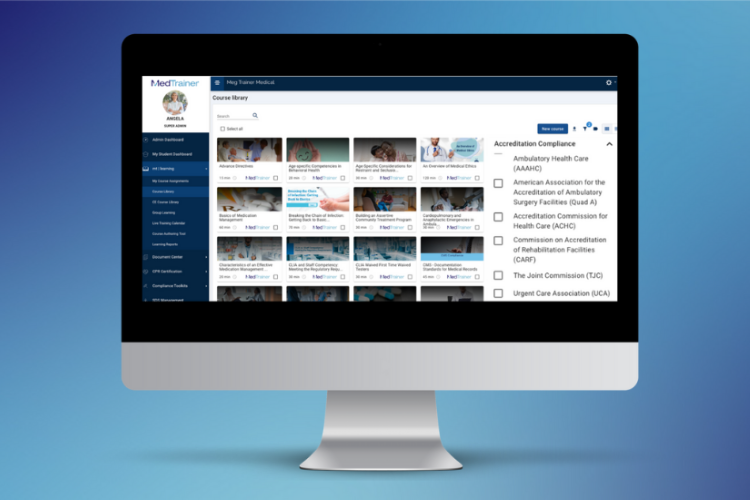It’s said you never stop learning, and that’s particularly true for healthcare professionals. Continuing education and training are crucial for maintaining licensure, staying compliant with regulations, and enhancing skills. However, the traditional approach to CE is expensive and increases the amount of time spent away from patients.
By strategically selecting CE courses that also satisfy regulatory requirements, healthcare organizations can create efficiencies, reduce redundancy, and improve overall staff satisfaction. The tricky part is finding these unicorns in a sea of courses. In this article, I’ll explain what to look for and where to find it.
Why Stack CE Courses and Compliance Training?
Every state has different requirements for licensure, including the number of continuing education (CEUs) required and the frequency. The traditional approach to fulfilling these requirements often involves the professional searching for viable options, paying to get access to online coursework, or taking time away from work to attend expensive conferences.
Since the healthcare organization is already providing required compliance training to meet regulatory and accreditation requirements, many are now also offering CEUs for staff. This is a huge perk for employees because of the time and money they can save by not having to find the credits on their own. By reducing the time and effort required to complete CE requirements, healthcare organizations can improve job satisfaction and reduce burnout among staff. Stacking continuing education and training takes it a step further — employees can earn CE credits while satisfying compliance requirements. It’s a win for everyone!
Watch On-Demand: Tips To Efficiently Meet Healthcare Training Requirements
Find Courses That Offer CE and Meet Compliance Requirements
Successfully implementing stacked healthcare continuing education and training requires a thoughtful and strategic approach — as well as approvals from accreditation bodies. If your education team creates content in-house, it might be more trouble than it’s worth to get course approval from an organization such as the American Nurses Credentialing Center (ANCC). If you’re using a healthcare LMS (learning management system), these approvals are likely already in place, so you just need to assign the right courses!
Start with your existing compliance training program since these courses are required. Then, see what you can find that satisfies these requirements and also offers continuing education credit.
Here are a few ideas:
Stack CE and State Requirements
Many states require human trafficking, opioid, cultural competency, implicit bias, and/or DEI (diversity, equity, and inclusion) training. These courses are probably the most likely to also offer CE credit, so look around until you find an option that offers continuing education and training in one.
Stack CE and Federal Requirements
Courses that are federally-required for many clinical roles within the organization are great ones to combine with continuing education credit. For example, choosing a course that meets OSHA’s infection prevention and control requirement with CE credit is a win for a large part of your staff. Another example may be training on critical incident reporting or prevention of abuse, neglect and exploitation. A course that explains these topics in depth along with the importance of accurate reporting, is often eligible for CE and meets training requirements at the federal and state levels.
Stack CE and Multiple Federal Requirements
This is truly the unicorn! If you can find a course that satisfies multiple federal requirements, and also offers CE, employees will be thrilled. Look for topics with similar content composition that may be required by different regulatory entities. For instance, if you were previously offering two different courses on topics like corporate compliance and documentation standards, both of which are aligned with compliance guidance issued by the Office of the Inspector General (OIG) and CMS, you’re now eliminating a redundant training because just one course will satisfy both training needs and provide CE credit.
Stack CE for Certification Renewal with Required Training
Some clinical staff, such as medical assistants and direct care personnel may not be licensed, but they are certified. The certifications require varying amounts of continuing education credit for renewal, so employees will really appreciate earning those valuable credits in conjunction with required compliance training. Look for training that is approved by certifying bodies such as the American Association of Medical Assistants or state-level certification entities. Courses on topics such as substance use, medication management, and medical error prevention often come with CE credit while satisfying state-specific regulatory requirements for non-licensed staff.
Choose an LMS That Stacks Continuing Education and Training
As you’ve likely realized, there are incredible opportunities to streamline licensure requirements for employees, while reducing the amount of time spent completing courses. This can do wonders for your operational efficiency and staff satisfaction.
Your best bet is to find courses where the hard work of matching regulations and getting CE approval is already done for you. This likely means choosing a healthcare-specific learning management system. When the vendor is completely committed to healthcare, the courses are already set up for the industry’s unique requirements and the appropriate CE approvals have been secured. Plus, a top healthcare LMS, such as MedTrainer, will have policy experts on staff who are reviewing changes consistently to ensure courses are updated.
Simplify compliance training with MedTrainer Learning
